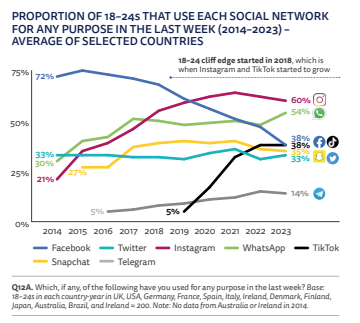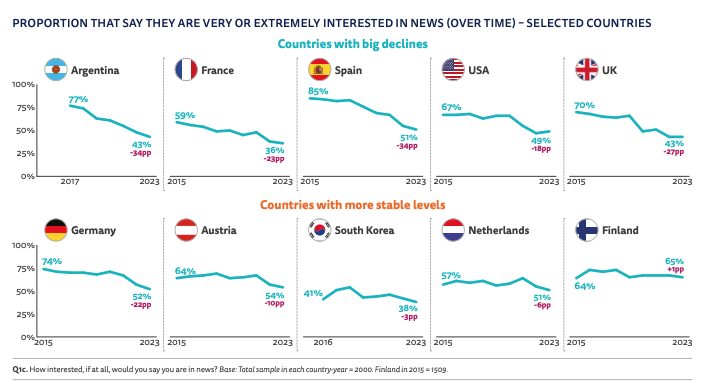
Left to right: Jane Barrett (Reuters), Kamal Ahmed (The News Movement), Rasmus Kleis Nielsen (RISJ) and Naja Nielsen (BBC News)
It is not enough to be present and visible on social media. Journalism itself must also be adapted in every way to suit online audiences. That was the topline of a panel at the launch of the Reuters Institute Digital News Report 2023.
The global report highlighted a widening generational gap in how people access the news. In the UK, for instance, a quarter of 18-24s use news websites or news apps as their first point of contact with a news brand. It is more than double that for over 35s. This gap has been widening ever since the coronavirus pandemic.
Social media is a fundamental part of most young people's daily routine but the landscape is quickly shifting. TikTok is just as popular as Facebook for 18-24s (38 per cent use generally). The difference is that while TikTok is surging, Facebook is spiralling down.

Screenshot: Reuters Institute Digital News Report 2023
Social media for news is a similar but less dramatic story. Facebook is falling but still sits at the top with 28 per cent of people who use it for news. Though TikTok has climbed up the rankings in recent years, it is only used for news by six per cent of respondents.
In a nutshell, social platforms are too popular for news brands to ignore. Being present on them is a given, but using them effectively is another matter. There are three main obstacles to consider.
Trust
The first is low levels of trust towards news content - 40 per cent of news audiences internationally say they trust the news generally, falling two percentage points from 2022. Social media has provided greater exposure to media criticism, which sometimes fuels distrust towards the media.
Then there are high levels of selective news avoidance - around a third (36 per cent) of people across markets sometimes or often actively avoid the news, two percentage points less than last year. People have, however, found different ways to avoid the news too: half simply flick past the news (periodic avoidance), half limit news only to certain times and a third avoid certain topics (these two are defined as specific avoidance).
Finally, interest in the news itself has taken a huge blow. Some countries, including the UK, have seen a heavy drop off in news junkies - people who say they are very or extremely interested in the news. Some countries like Argentina and Spain report as much as a 34 percentage points drop in the last six years.

Screenshot: Reuters Institute Digital News Report 2023
"Variety is the key to this ecology"
Media organisations have been too slow to keep up with shifting audience patterns and expectations. Bad actors have filled the void with misinformation, says Kamal Ahmed, co-founder and editor-in-chief of social-first newcomer The News Movement (TNM) at the launch event.
TNM has evolved quickly in its first three years serving up non-partisan, TikTok-style news content. It has since moved to acquire US startup Recount America, and it is also working on a new brand called Capsule centred on the world of fashion and celebrities.
The data shows how it is personalities that primarily drive news consumption on more youthful platforms like TikTok (55 per cent), Snapchat (55 per cent), Instagram (52 per cent) and YouTube (45 per cent). But "ordinary people" also emerged as an important element of news consumption on TikTok (44 per cent).
TNM shapes its content with these preferences in mind. It produces presenter-led 'face-first journalism'. But its most successful format is word-driven explainers, which show single words on the screen and a borrowed style from gaming YouTubers.
@thenewsmovement What are the UK’s abortion laws? (📸: AP, PA) #abortion #abortionpill #abortionlaw #uk #pregnant #womenshealth #reproductiverights
♬ original sound - The News Movement
"Journalism must learn from what is successful in social areas, but never, ever lose the DNA of your business which gives you trust," he says.
Variety of content matters a lot, hence its expansions. But Ahmed illustrates a finer point, that young audiences are not necessarily turning away from news content, as they are from content which simply is not speaking their language.
"We can't keep shouting at young people to consume material that does not interest them very much," he continues. "Understand your lane. The 'one size fits all model' really struggles in social media spaces."
'Digital-first is not just about distribution'
It is a position well-understood at BBC News, which after heavy resistance to join TikTok, finally climbed onboard to debunk untruths surrounding the Ukraine War and provide trustworthy news to Russian audiences. It is now sticking around and posting more generally.
It is an uncomfortable position for the public broadcaster used to being a dominant source of news domestically both online and offline. It is more of a "challenger" brand in new social spaces and in overseas markets, says Naja Nielsen, director of BBC News.
Nielsen - formerly head of news at DR, the public broadcaster in her native Denmark - claims that Scandinavian countries see better figures around trust, people who pay for news and media innovation, in part because they have forward-thinking public service media fuelling a strong media ecosystem.
The UK has a long way to go to match the figures seen in Norway and Sweden, with more than a third paying for online news, and half trusting it. Finland also has the highest trust ranking on the survey at 69 per cent.
But to really start tackling issues of trust, news avoidance and interest in the news at home, she plans to make some seismic changes to the journalism being produced.
Shift in media use is accompanied by 'generalised scepticism', not just low trust in news found via social and search (as we have shown before) but also concern over whether online news is real or fake (esp. among those who say they mainly use social media as source of news) 3/9 pic.twitter.com/1I8wcbQ88K
— Rasmus Kleis Nielsen (@rasmus_kleis) June 13, 2023
This year saw the launch of BBC Verify, a specialised team of around 60 journalists, pulling together existing teams including, the User Generated Content team, the World Service Disinformation team, the Monitoring Disinformation team, Reality Check and Data and Analysis with stars Ros Atkins and Marianna Spring.
Misinformation remains an issue with online audiences. Across all markets, around half (56 per cent) of people worry about the difference between what is real and fake on the internet when it comes to news – up two percentage points on last year.
Verify content will peel back the curtain on how BBC journalism is produced and why it can be trusted. This will be peppered into its content across radio, TV and online.
"We have wasted time in the media business thinking we could get away with only changing the distribution model, and not changing the actual journalism,” says Nielsen.
"We need to change journalism as well, it needs to have a broader agenda, it needs to be more constructive, more rounded, not only negative. It's not that we should shy away from the hard stuff, but we need to do other [content] too."
Those interested in the hard, heavy news agenda, she adds, are around a tenth of the population and are predominantly white, elderly men. Other readers simply have other needs.
"I don’t believe for a second that there are people who never want to hear about negative stories.
"They do want to hear about problematic, negative or conflict-driven stories at certain moments - information that clarifies what's going on. But then they want to go back to all the other priorities in their lives."
A solution on the horizon
The buzzword of the moment is still artificial intelligence. The precarious state of trust - just around half (46 per cent) of respondents trust the news sources they use - is another reason to be both curious and cautious about the technology.
Jane Barrett, global news editor, media news strategy, Reuters is optimistic that most of the issues highlighted in the DNR could one day be solved by AI. That might mean, for example, AI taking care of data sets and press conferences, and by doing so, lessening the load on reporters to focus on the real ‘audience satisfying journalism’.
There is still a way to go until that is a viable reality. Reuters has been working with data scientists for years in this space, who have been ecstatic to see 85 per cent accuracy results - which is encouraging but not an acceptable standard for newsrooms.
Generative AI tools are clearly not flawless yet but that is also precisely why journalists cannot ignore them.
"The famous human in the loop is really critical for our brands and the trust we have," says Barrett.
Reuters has a firm rule that a human always checks anything made by AI, and the human is accountable and responsible for any errors. The only exception might be translation tools where there is a near-perfect accuracy confidence, but even then disclaimers are used to demystify the process.
"The last thing we want to do is damage our own trust by relying on machines, making a stupid error and shooting ourselves in the foot," she concludes.
Free daily newsletter
If you like our news and feature articles, you can sign up to receive our free daily (Mon-Fri) email newsletter (mobile friendly).
Related articles
- RISJ Digital News Report 2024: User needs with Vogue and The Conversation
- RISJ Digital News Report 2024: Three essential points for your newsroom
- RISJ Digital News Report 2024: Five trends to watch in the UK
- Why TikTok star Sophia Smith Galer created an AI tool to help journalists make viral videos
- The Journalism Trust Initiative is rewarding transparent and trustworthy news









